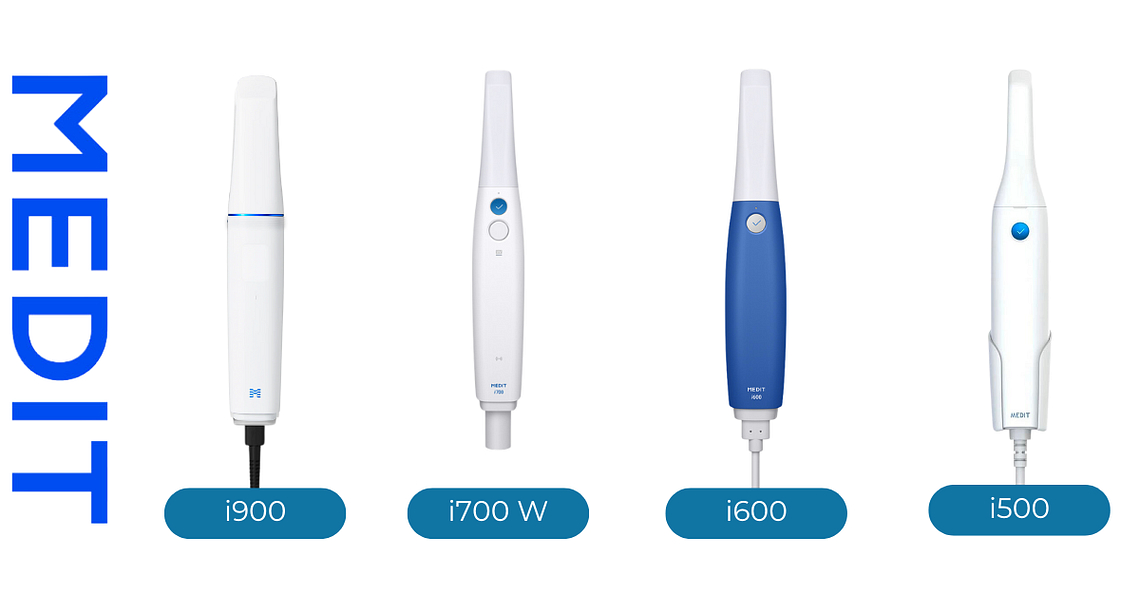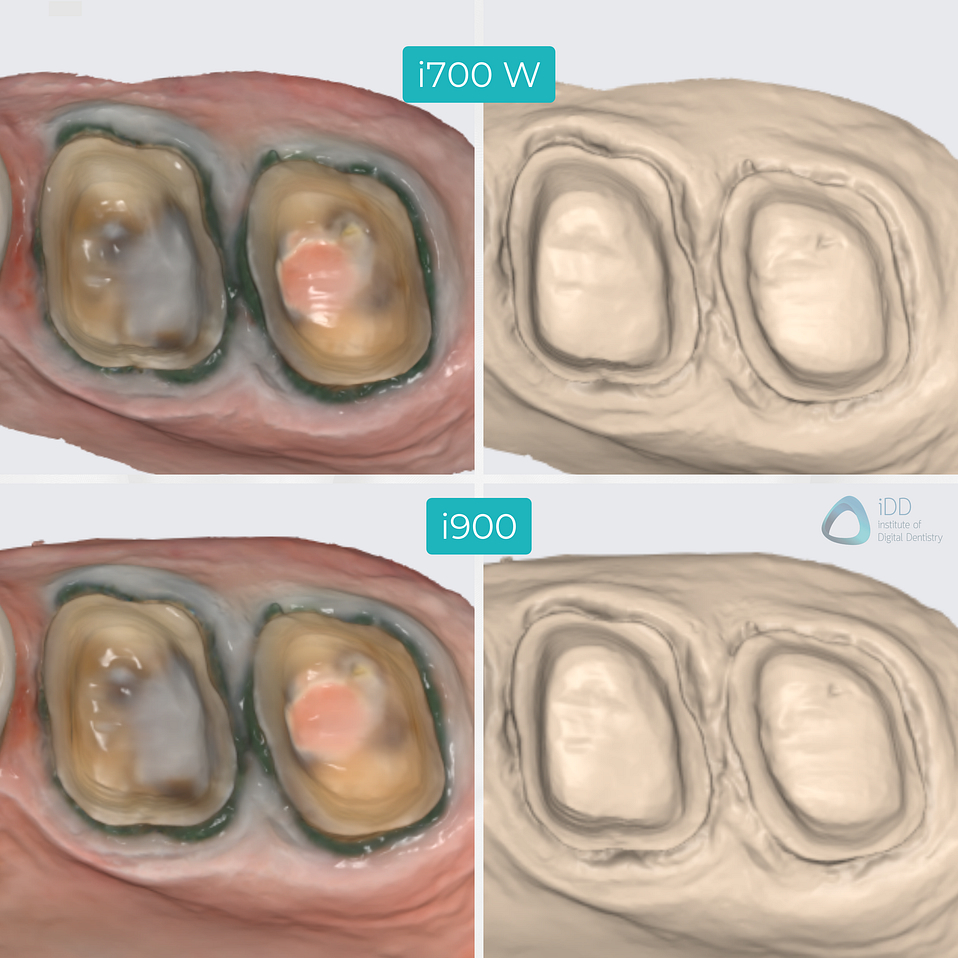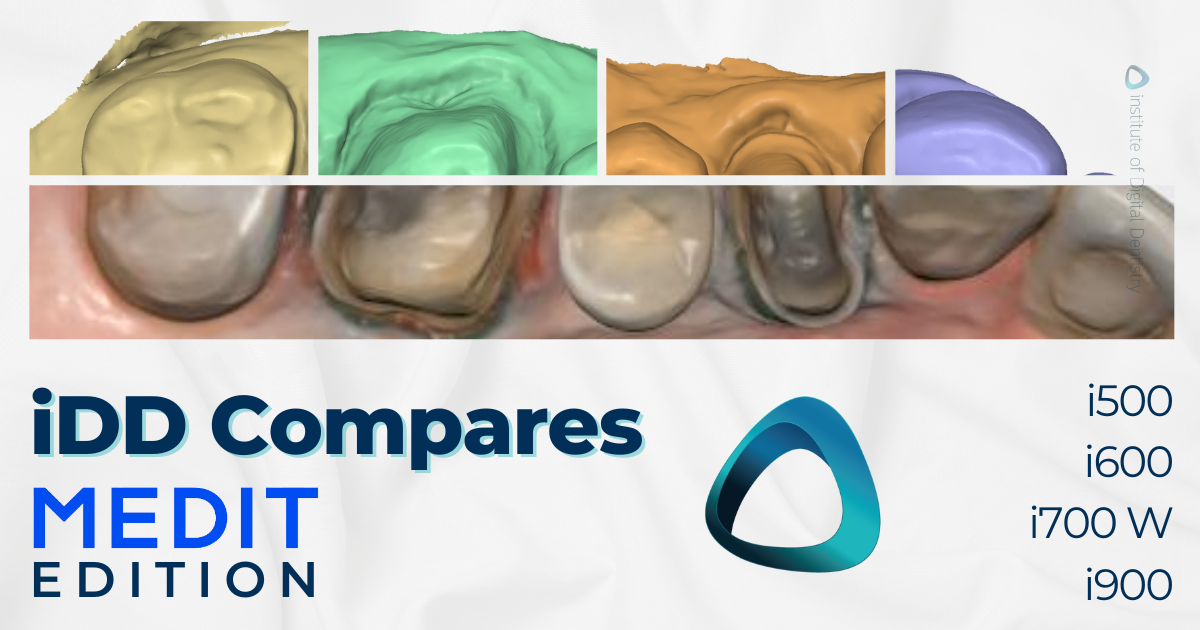Our previous iDD Compares, which included Medit i900 and iTero Lumina, was well-received, so why not continue to follow the buzz surrounding these new releases.
In April, we previously compared Medit’s portfolio of intraoral scanners (IOS), i500 vs. i600 vs. i700.
This was before the launch of the Medit i900, their latest flagship intraoral scanner, which we now have at iDD and can compare and review at length for you.
Now that it is here, it is time to update our Medit comparison by seeing how all the different Medit scanners scan the same case.
As always, iDD is lucky to have access to all intraoral scanners on the market and to test them on real cases and actual patients in a clinical environment.
By doing so, we can provide an honest and unbiased review when comparing the performance of each IOS.
For this iDD Compares, I scanned the same patient, the same 14 and 16 crown preps, with four different Medit intraoral scanners in the same appointment:

From left to right: i900,i700 W (i700 Wireless), i600, and i500 by Medit.
Check out the results below, including pictures of the color scan, exported STLs, tessellated mesh, and a close-up of the prep margin.
Individual Scans in their Native Software
Each intraoral scanner has its own advanced scanning software. Most scanners utilize AI to automatically remove scan artifacts, including movable soft tissue, cheeks, and tongue, with varying degrees of effectiveness.
Medit scanners use Medit Link and Medit Scan for Clinics.
Using the scanner's native software, we can preview how these scanners capture color, also known as texture.
Oh, by the way, we finish all these cases with in-house crowns. Below is a prep intraoral image taken with a DSLR and the finished 14 and 16 crown restorations, and after cementation.

Which Medit scanner is the best – i900, i700, i600 or i500?
Well, it’s interesting to use each scanner back to back because you really get an idea of the pros and cons of each one.
Let's start with the Medit i500.
For starters, it's still an decent scanner to be frank. Even though it was released 6 years ago in 2018. Especially if you just want a scanner for basic things like crown and bridge work. Although it has been replaced by the i600, it handled the scan of these two teeth preps well enough. By an obvious margin, it was the slowest scanner out of the four. This is as expected. The Medit i500 has the smallest scan head. It was also a blast from the past having to plug it into the wall using the adapter, which was annoying compared to the simple USB-C connection of the other scanners. Quadrant scan completed in around 50 seconds.
Next, we have the Medit i600 and i700.
These scanners felt identical in the scanning process. No major difference between these two models. They both could scan the quadrant in around 35 seconds. The larger scan head helps, and overall there is a big difference when compared to the i500. The main difference I can think of is that the i700 comes in wireless. Wireless does feel more ergonomic to use, but you have to deal with batteries rather than just plugging in and away you go.
Finally, the Medit i900.
This scanner was clearly faster than the i500, i600, and i700. Not quite the same jump between the i500 and, say the i700/i600, but it’s decent enough that this will be my Medit scanner of choice if I had to use one. The scanner requires much less warm-up time compared to the others, which was noticeable, and it scans faster thanks to the significantly larger scan head. Medit also offers medium and small tips for smaller mouths.
Overall, all scanners handled this prepration scan easily. The i900, as expected, felt like it was the best out of the 4 scanners, but you could pick up any of these and make this work.
Overall, the Medit software is enjoyable to use as the scan images look really high res and sharp when scanning, across all scanners.
Download all the scan images at 5x higher resolution?
Is there a difference in color capture between the Medit scanners?
So, with the release of the i900, the company stated that this is a new generation scan engine, not just a rehashed i700 (kinda like the i600).
For this reason, I was expecting the i900 to look quite different, but it still shares the same ‘Medit DNA’ as the others. If I saw this scan and didn’t know it came from an i900, I would recognize it looks like Medit in other words.
If you compare i500 to i600/i700 to i900, it does look like the image gets sharper and sharper. But the difference between all four scanners is not huge.
The Medit i900 looks like the sharpest scan and has slightly different colors. I think the most notable difference I can observe is that the i900, seems to show more definition with its scan. By this, I mean that the i900’s scan has more contrast than the scans of i500, i600, and i700, allowing for more detail to be seen.

The processed color scans of the same tooth preparations were captured using four different Medit intraoral scanners, as previewed in their native software.
All scans portray the same illustrative (not photorealistic) scan display.

The processed monochromatic scans of the same tooth preparations were captured using four different Medit intraoral scanners, as previewed in their native software.
Now, when we look at the scans in monochrome, our observations are different from that of the colored scans.
Once again all four scans are very, very similar.
If we are to nitpick, the i500 scan seems to show slightly more definition around the prep margins and when looking at the detail of the prep. This is closely followed by the i700. Oddly enough, the i900 doesn’t seem to have as high definition in its monochrome scans when compared to its colored scan. I am looking particularly at the first molar distal margin.
Here is another case scanned with the i700 and i900. To compare this further.

The i700 looks a tad sharper with more defined margins than the i900. The color texture between these two scanners is similar. Interesting.
The last question that comes to mind is, does HD mode make a difference? I will cover this in another comparison.
Download all the scan images at 5x higher resolution?
Exported Scans in Third-Party Software
Intraoral scanners all have an open architecture, enabling scans to be exported and transmitted to laboratories.
These scans are typically exported in three different formats: STL, PLY, or OBJ files.
STL files are exported as monochromatic scans, while OBJ and PLY files store color information, also known as texture.
Medit happens to be one of the few intraoral scanner companies that enables exporting scans in all three file formats: STL, PLY, and OBJ.
Intraoral Scanner | STL | PLY | OBJ |
|---|---|---|---|
Medit i900 | 11.8 MB | 4.9 MB | 12.1 MB |
Medit i700 W | 9.9 MB | 4.1 MB | 9.7 MB |
Medit i600 | 6.4 MB | 2.6 MB | 6.3 MB |
Medit i500 | 11.2 MB | 4.6 MB | 11.2 MB |
Interestingly, the i900 and i500 seem to have the largest file size.
The i600 with the capped FPS at 30 frames has the lowest, which is expected.

All scans were exported in an STL format and previewed in the Medit Design app.
Labs often use third-party CAD software like exocad to view cases and design prosthetics.
In this case, we used Medit Design to preview the STL, PLY, or OBJ files and to take a closer look at the amount and detail of data captured within each scan.
By exporting the scans outside their native software, we can view them objectively without the customized color and optimized surface rendering of the individual scanner’s built-in software.

When we observe each tessellated mesh, the i900 and i500 seem to have the densest mesh.
We may assume that the i900 is only slightly denser when we compare its STL file format size of 11.8 MB to the i500’s of 11.2 MB.
It is interesting to see that this is the case, considering the i900 was recently launched in April 2024 and the i500 in late 2018—that’s a six-year difference between the IOS technology and AI software of Medit’s latest and first IOS devices.
Studies investigating the clinical significance of mesh density have yet to be conducted. It is important to note that a denser mesh does not necessarily indicate a ‘better scan.’ Prep margins can also be reviewed using this software.


Although the i500 was the earliest IOS from Medit’s range of scanners, it seems to hold up well. Even after all these years, the margin lines captured using the i500 are detailed. i900 also looks markedly sharper than the i700/i600. Interesting.
Download all the scan images at 5x higher resolution?
Overall, all of the Medit scanners did a very good job.
When looking for deviations, we allocated the i900 as our point of reference, as it is the most recent, to compare all other scanners.

Deviation map of the scans as compared to i900’s scan and sectional view. There seems to be minimal deviation around the prep area.
Based on the colored deviation key, we can see that the scan meshes are within 50 microns compared to the scan taken with the Medit i900.
Within the same Display mode, we can also view the aligned scans in a sectional view in which we can see minimal differences between the scans. They all seem to capture the same geometric shape the same. Given the fit of the crowns, we can assume accurately.
I think it is safe to say that all four Medit IOS work and are accurate, especially given the huge number of i700s that have been installed and are used daily around the world.
Conclusion
The precision in capturing the details of the restoration preparation can vary slightly depending on the combination of the clinician's scanning technique and the specific scanner used. This is an essential factor to keep in mind.
The i900 seems to be a marked improvement over the i600 and i700 in terms of scanning experience. Thanks to its smaller weight, larger scan head size and very fast warm-up period. The scans themselves across all Medit scanners are very similar, even when compared to the 6 year old Medit i500.
All Medit scanners, did a good job when scanning. Is scanning technology plateauing?
The final scan result looked good whether you use an i500 or i900. The difference is with the i900, the form factor and ergonomics. Being 165 grams it is much more enjoyable to use than the other Medit scanners. Unless you want a wireless scanner, then you may go for an i700W.
Let us know your thoughts. What scanners should we compar next?

